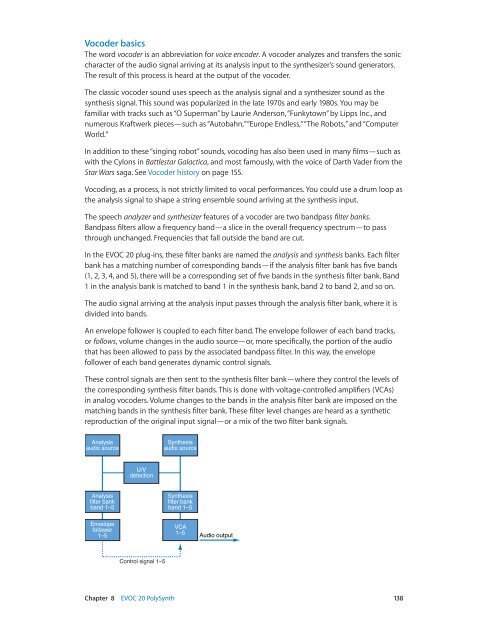Apple MainStage 3 Instruments - MainStage 3 Instruments
Apple MainStage 3 Instruments - MainStage 3 Instruments
Apple MainStage 3 Instruments - MainStage 3 Instruments
Create successful ePaper yourself
Turn your PDF publications into a flip-book with our unique Google optimized e-Paper software.
Vocoder basics<br />
The word vocoder is an abbreviation for voice encoder. A vocoder analyzes and transfers the sonic<br />
character of the audio signal arriving at its analysis input to the synthesizer’s sound generators.<br />
The result of this process is heard at the output of the vocoder.<br />
The classic vocoder sound uses speech as the analysis signal and a synthesizer sound as the<br />
synthesis signal. This sound was popularized in the late 1970s and early 1980s. You may be<br />
familiar with tracks such as “O Superman” by Laurie Anderson, “Funkytown” by Lipps Inc., and<br />
numerous Kraftwerk pieces—such as “Autobahn,” “Europe Endless,” “The Robots,” and “Computer<br />
World.”<br />
In addition to these “singing robot” sounds, vocoding has also been used in many films—such as<br />
with the Cylons in Battlestar Galactica, and most famously, with the voice of Darth Vader from the<br />
Star Wars saga. See Vocoder history on page 155.<br />
Vocoding, as a process, is not strictly limited to vocal performances. You could use a drum loop as<br />
the analysis signal to shape a string ensemble sound arriving at the synthesis input.<br />
The speech analyzer and synthesizer features of a vocoder are two bandpass filter banks.<br />
Bandpass filters allow a frequency band—a slice in the overall frequency spectrum—to pass<br />
through unchanged. Frequencies that fall outside the band are cut.<br />
In the EVOC 20 plug-ins, these filter banks are named the analysis and synthesis banks. Each filter<br />
bank has a matching number of corresponding bands—if the analysis filter bank has five bands<br />
(1, 2, 3, 4, and 5), there will be a corresponding set of five bands in the synthesis filter bank. Band<br />
1 in the analysis bank is matched to band 1 in the synthesis bank, band 2 to band 2, and so on.<br />
The audio signal arriving at the analysis input passes through the analysis filter bank, where it is<br />
divided into bands.<br />
An envelope follower is coupled to each filter band. The envelope follower of each band tracks,<br />
or follows, volume changes in the audio source—or, more specifically, the portion of the audio<br />
that has been allowed to pass by the associated bandpass filter. In this way, the envelope<br />
follower of each band generates dynamic control signals.<br />
These control signals are then sent to the synthesis filter bank—where they control the levels of<br />
the corresponding synthesis filter bands. This is done with voltage-controlled amplifiers (VCAs)<br />
in analog vocoders. Volume changes to the bands in the analysis filter bank are imposed on the<br />
matching bands in the synthesis filter bank. These filter level changes are heard as a synthetic<br />
reproduction of the original input signal—or a mix of the two filter bank signals.<br />
Analysis<br />
audio source<br />
Synthesis<br />
audio source<br />
U/V<br />
detection<br />
Analysis<br />
filter bank<br />
band 1–5<br />
Synthesis<br />
filter bank<br />
band 1–5<br />
Envelope<br />
follower<br />
1–5<br />
VCA<br />
1–5<br />
Audio output<br />
Control signal 1–5<br />
Chapter 8 EVOC 20 PolySynth 138
















